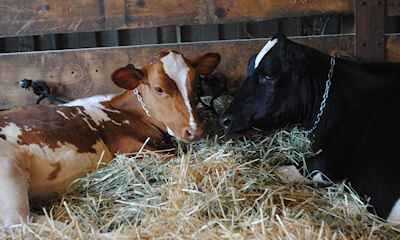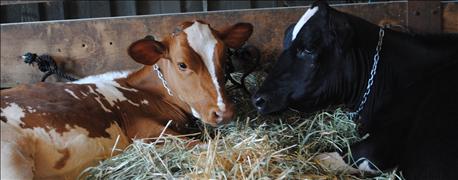May 21, 2015

By Ryan Sterry
As heifer rearing costs have increased, achieving a younger average age at first calving has been a goal for many dairies. When rearing costs and animal performance are both factored in, the research shows first calving ages of 22 to 24 months to be optimal for Holstein heifers. With the research to back it up, and the economic motivation from higher heifer raising costs, the goal is clear on many farms to manage breeding to calve in heifers at a younger average age of 23 to 24 months.

Breeding dairy heifers by age rather than size may be a very effective new way to manage heifer breeding to achieve goals for age at first calving.
However, what is often overlooked in achieving this benchmark is how we get there? Obviously this means breeding heifers at a younger age, but how young do we dare go? Are most of our heifers calving close to their target age for their first calf, or do we still have several slipping by at 28, 30, months of age or more at first calving?
This is where looking just at the average can be deceiving. Let's look at an example. Both Farm A and Farm B have an average age at first calving of 24 months, right on target for their goals. For the past year we go back and look at the individual calving records from each farm. Farm A has a minimum age at first calving of 22 months, maximum age of 27 months, and 90% of the heifers calve within plus or minus one month of the target of 24 months (between 23 and 25 months). Farm B has a minimum age at first calving of 20 months, maximum of 31 months, and 90% of the heifers calve three months plus or minus of the target (between 21 and 27 months).
These two farms have both reached an aggressive target average age at first calving of 24 months, but Farm B still has several heifers calving at 27 or more months of age. o make up for this they've steadily decreased the age they start breeding at and have to calve several heifers at 22 months or less to bring their average down. While both farms have the same average age at calving, Farm B's is rather deceiving as they're losing performance and money from too many heifers calving in too young or too old. For Farm A to achieve their goal, they've had to put an emphasis on heat detection and high conception rates for their heifers to achiever not only a younger age at first calving, but also to have the majority of their heifers calve between 23 and 25 months of age.
~~~PAGE_BREAK_HERE~~~
How does your farm compare? Victor Cabrera with UW-Extension has developed an easy to use spreadsheet tool for calculating these numbers for your own farm, including average age at first calving, distribution of youngest to oldest, true heifer pregnancy rate, and more. All you need are the IDs of heifers that have calved in the past year and their age in months at calving. It doesn't get much simpler than that. This tool can be found online at: http://dairymgt.uwex.edu/tools.php
Think outside the box
Now to really think outside the box on heifer breeding, a recent trial by Pat Hoffman at the Marshfield Ag Research Station tested the notion that heifers should be bred only after achieving a certain size. Two groups of heifers were tested. One group received their first A.I. only after reaching 875 pounds in weight. The second group was screened at 12 months of age. If they were 800 pounds by that time, they were bred at their first heat after 13 months of age.
The preliminary results show that the group bred by age has a much narrower range in age at first calving, with the majority of heifers calving between 22 and 24 months of age and no heifers calving younger than 22 months. There was no difference in first lactation milk, fat, or protein yield between the two groups. Days to first service and days open during their first lactation were also similar. While these were well grown heifers, these preliminary results show that breeding by age rather than size may be a very effective new way to manage heifer breeding to achieve goals for age at first calving.
Sterry is the St. Croix County Extension agriculture agent.
You May Also Like




